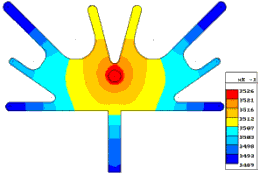Kelvin, Celsius, Elastoby Integrated Engineering Software
KELVIN (2D/RS) and CELSIUS (3D) are standalone thermal packages and ELASTO (2D/RS) is a fully functional structural package, all using the same innovative Boundary Element Method as the rest of Integrated Software electromagnetic tools.
 Explore the full possibilities of time saving, cost-effective product design optimization with Integrated Engineering Software’s thermal and structural analysis tools. KELVIN (2D/RS) and CELSIUS (3D) are standalone thermal packages and ELASTO (2D/RS) is a fully functional structural package, all using the same innovative Boundary Element Method as Integrated’s electromagnetic tools. Explore the full possibilities of time saving, cost-effective product design optimization with Integrated Engineering Software’s thermal and structural analysis tools. KELVIN (2D/RS) and CELSIUS (3D) are standalone thermal packages and ELASTO (2D/RS) is a fully functional structural package, all using the same innovative Boundary Element Method as Integrated’s electromagnetic tools.
Coupled Analysis – The complete electromagnetic/mechanical solution of a device is obtained by coupling the tools, using the electromagnetic power loss or force output as input for the thermal and structural analysis.
Design engineers depend on KELVIN, CELSIUS and ELASTO for coupled thermal/mechanical and electromagnetic applications including:
- electronic packaging
- appliances
- automotive components
- aerospace components
- electromagnetic devices
- electromechanical devices
Quick, productive...up and running in no time
KELVIN, CELSIUS and ELASTO maximize productivity by allowing for the simulation of virtual prototypes on the computer. These tools significantly reduce design and prototype costs and provide engineers far greater insight into design optimization and verification.
As easy as one, two, three
KELVIN, CELSIUS and ELASTO provide fast accurate results, exact modeling of boundaries and easy analysis of open region problems. No Finite Element Mesh (FEM) is required. KELVIN, CELSIUS and ELASTO deliver a powerful, easy-to-use design and analysis tool right to your desktop. KELVIN, CELSIUS and ELASTO go to work in just three easy steps.
- Create your design through our geometric modeler or import from your CAD program.
- Assign the physical attributes of the model.
- Analyze the model, display the results and optimize for performance.
Advanced technical features for KELVIN and CELSIUS
- Temperature, temperature gradient and heat flux values can be displayed using contour plots, profile plots, arrow plots and graphs
- Boundary conditions such as temperature, heat flux, temperature gradient, convective and radiative heat exchange are easily assigned
- Heat sources can be assigned in the form of volume heat and surface heat
- Material table stores thermal conductivity, specific heat, mass density or absorption and scattering coefficients
- Display temperature, heat flux and temperature gradients in the form of contour plots, surface representations and graphs
Advanced technical features for ELASTO
- Boundary conditions such as traction, displacement and symmetry
- Displacement and stress field values
- Displacement components displayed in the form of contour plots, surface representations, arrow plots and graphs
- Stress components displayed in the form of contour plots, surface representations and graphs
- Elastic modulus, Poisson ratio and thermal expansion coefficient are stored in the material tables
|

